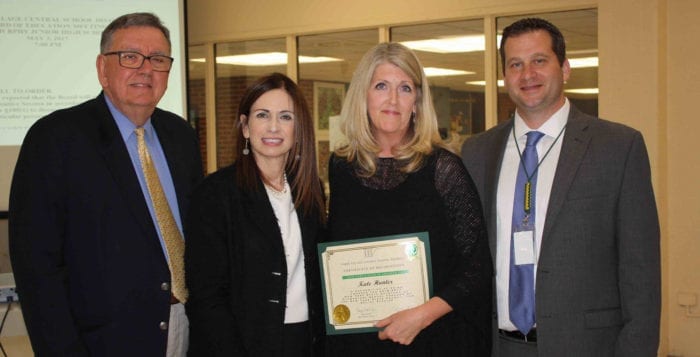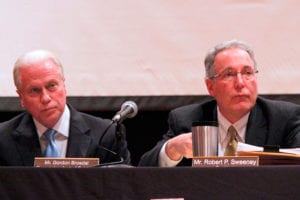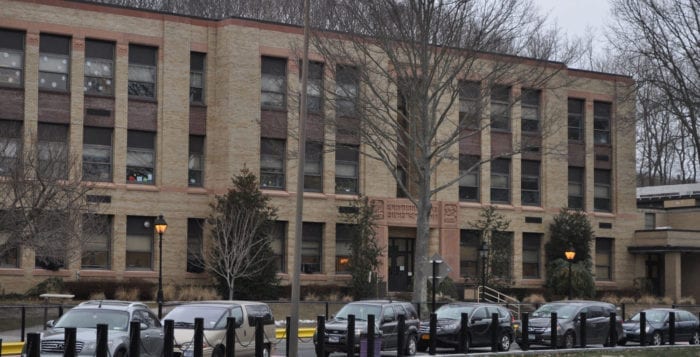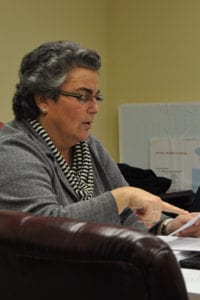By Andrea Paldy
The Three Village Central School District board kicked off its first meeting of the school year with a celebration of one of the district’s teachers receiving a national award.
Teacher of the year
Fifth-grade teacher Kate Hunter’s achievement was the highlight of the evening.
“I feel like it’s déjà vu all over again,” Minnesauke principal Brian Biscari said.
Over the past year, the principal and the board have congratulated Hunter for her accolades as New York State Council for the Social Studies Outstanding Elementary Social Studies Classroom Teacher Award. She had received a similar award earlier from the Long Island Council for the Social Studies. This time, Hunter received a standing ovation for being named National Council for the Social Studies Elementary Level Social Studies Teacher of the Year, which recognizes “exceptional classroom social studies teachers.”
Hunter, who has taught fifth grade for 10 years, began her career in the district at Minnesauke in 2003. This November, she will attend the national NCSS conference in San Francisco, where she will receive her award and present some of her work.
The meeting’s agenda also included a presentation from the director of elementary curriculum and a policy update about home schoolers. Additionally, the school board heard concerns about a summer reading assignment.
Summer reading

Toni Williams-Mulgrave expressed dismay about the summer reading assignment, “Leaving Fletchville,” for
R.C. Murphy Junior High School’s eighth-graders. A Ward Melville graduate and educator herself, Williams-Mulgrave, who is African-American, has a niece who read the assignment.
She told the school board that she was disturbed by the stereotyping and racial slurs in the book.
“Someone has to speak up, and we have to start the communication so that our society can grow — so that the stuff that’s going on across the world doesn’t happen here,” she said.
The family had met with district officials during the summer, and the reading assignment was canceled before the start of the school year.
The book, about siblings who’ve moved to a place where they are “the only black people in town,” was nominated for the 2010 Red Maple Award for seventh- and eighth-grade Canadian literature.
In a prepared statement, board president William Connors said that the district’s decision “to eliminate this year’s summer reading project was based on the interest of our students and primarily the connection one aspect of the book had to national events transpiring this summer — events that occurred well after the book was chosen.”
“Our district is strongly committed to creating learning environments that promote acceptance, respect and inclusivity as well as a rich curriculum encompassing the literary classics and emerging prize-winning authors,” Connors said.
District superintendent Cheryl Pedisich also addressed the matter. In her statement, she said that the district’s program review committee will review independent summer reading assignments this year and make “any recommended changes” they believe will further benefit students.
Elementary curriculum
Director of elementary curriculum Nathalie Lilavois unveiled the first part of a program that she said would
help boost the district’s goal of guiding students towards becoming “skilled problem solvers, perceptive thinkers, quality producers, lifelong learners and self-directed learners.”
Lilavois’ first focus is elementary math. She explained that she prepared a document that lays out the district’s elementary-level math curriculum and articulates how it aligns to the math learning standards. Lilavois made the material available to teachers on an expansive, interactive website that makes it easier for them to use in the classroom.
The site is organized by grade and then by topic. It has core-aligned resources, including GoMath — the district’s math program — and other websites that provide supplemental information and approaches to each focus area. The online project also enables teachers to suggest their own resources and ideas.
Lilavois will continue to build the site for all elementary subject levels and is developing the English language arts program this year.
In other business, the district updated several policies as required by statute. It also amended a policy to allow homeschooled students in the district to participate in noncredit and nonathletic extracurricular activities such as clubs.


















